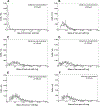Single-cell determination of iron content in magnetotactic bacteria: implications for the iron biogeochemical cycle
- PMID: 31187921
- PMCID: PMC7051126
- DOI: 10.1111/1462-2920.14708
Single-cell determination of iron content in magnetotactic bacteria: implications for the iron biogeochemical cycle
Abstract
Magnetotactic bacteria (MTB) are ubiquitous aquatic microorganisms that mineralize dissolved iron into intracellular magnetic crystals. After cell death, these crystals are trapped into sediments that remove iron from the soluble pool. MTB may significantly impact the iron biogeochemical cycle, especially in the ocean where dissolved iron limits nitrogen fixation and primary productivity. A thorough assessment of their impact has been hampered by a lack of methodology to measure the amount of, and variability in, their intracellular iron content. We quantified the iron mass contained in single MTB cells of Magnetospirillum magneticum strain AMB-1 using a time-resolved inductively coupled plasma-mass spectrometry methodology. Bacterial iron content depends on the external iron concentration, and reaches a maximum value of ~10-6 ng of iron per cell. From these results, we calculated the flux of dissolved iron incorporation into environmental MTB populations and conclude that MTB may mineralize a significant fraction of dissolved iron into crystals.
© 2019 Society for Applied Microbiology and John Wiley & Sons Ltd.
Figures




Similar articles
-
Magnetotactic Bacteria Accumulate a Large Pool of Iron Distinct from Their Magnetite Crystals.Appl Environ Microbiol. 2020 Oct 28;86(22):e01278-20. doi: 10.1128/AEM.01278-20. Print 2020 Oct 28. Appl Environ Microbiol. 2020. PMID: 32887716 Free PMC article.
-
Influence of protozoan grazing on magnetotactic bacteria on intracellular and extracellular iron content.Environ Microbiol Rep. 2023 Jun;15(3):181-187. doi: 10.1111/1758-2229.13140. Epub 2023 Feb 13. Environ Microbiol Rep. 2023. PMID: 36779255 Free PMC article.
-
The effect of iron-chelating agents on Magnetospirillum magneticum strain AMB-1: stimulated growth and magnetosome production and improved magnetosome heating properties.Appl Microbiol Biotechnol. 2012 Nov;96(3):663-70. doi: 10.1007/s00253-012-4199-5. Epub 2012 Jun 16. Appl Microbiol Biotechnol. 2012. PMID: 22707052
-
Iron-biomineralizing organelle in magnetotactic bacteria: function, synthesis and preservation in ancient rock samples.Environ Microbiol. 2020 Sep;22(9):3611-3632. doi: 10.1111/1462-2920.15098. Epub 2020 Jun 22. Environ Microbiol. 2020. PMID: 32452098 Review.
-
Bacterial magnetosome and its potential application.Microbiol Res. 2017 Oct;203:19-28. doi: 10.1016/j.micres.2017.06.005. Epub 2017 Jun 20. Microbiol Res. 2017. PMID: 28754204 Review.
Cited by
-
Correlative SIP-FISH-Raman-SEM-NanoSIMS links identity, morphology, biochemistry, and physiology of environmental microbes.ISME Commun. 2022 Jun 30;2(1):52. doi: 10.1038/s43705-022-00134-3. ISME Commun. 2022. PMID: 37938730 Free PMC article.
-
Magnetic genes: Studying the genetics of biomineralization in magnetotactic bacteria.PLoS Genet. 2020 Feb 13;16(2):e1008499. doi: 10.1371/journal.pgen.1008499. eCollection 2020 Feb. PLoS Genet. 2020. PMID: 32053597 Free PMC article. Review.
-
Identification and Genomic Characterization of Two Previously Unknown Magnetotactic Nitrospirae.Front Microbiol. 2021 Jul 27;12:690052. doi: 10.3389/fmicb.2021.690052. eCollection 2021. Front Microbiol. 2021. PMID: 34385986 Free PMC article.
-
Magnetotactic bacteria: concepts, conundrums, and insights from a novel in situ approach using digital holographic microscopy (DHM).J Comp Physiol A Neuroethol Sens Neural Behav Physiol. 2022 Jan;208(1):107-124. doi: 10.1007/s00359-022-01543-4. Epub 2022 Feb 22. J Comp Physiol A Neuroethol Sens Neural Behav Physiol. 2022. PMID: 35194649 Review.
-
Revealing the diversity of bacterial and archaeal organelles via comparative genomics.Mol Biol Cell. 2025 May 1;36(5):pe4. doi: 10.1091/mbc.E20-08-0564. Mol Biol Cell. 2025. PMID: 40333210 Review.
References
-
- Amor M, Busigny V, Louvat P, Gélabert A, Cartigny P, Durand-Dubief M, Ona-Nguema G, Alphandéry E, Chebbi I, Guyot F (2016) Mass-dependent and -independent signature of Fe isotopes in magnetotactic bacteria. Science 352: 705–708. - PubMed
-
- Amor M, Louvat P, Tharaud M, Gélabert A, Cartigny P, Carlut J, Isambert A, Durand-Dubief M, Ona-Nguema G, Alphandéry E, Chebbi I, Guyot F (2018) Iron uptake and magnetite biomineralization in the magnetotactic bacterium Magnetospirillum magneticum strain AMB-1: an iron isotope study. Geochem. Cosmochem. Acta 232: 225–243.
-
- Blakemore RP (1982) Magnetotactic bacteria. Ann. Rev. Microbiol 36: 217–238. - PubMed
-
- Calugay RJ, Miyashita H, Okamura Y, Matsunaga T (2003) Siderophore production by the magnetic bacterium Magnetospirillum magneticum AMB-1. FEMS Microbiol. Lett 218: 371–375. - PubMed

